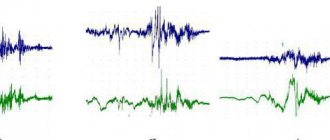Dopplerometry during pregnancy is a modern diagnostic method using ultrasound, which allows you to objectively and fully examine the blood circulation of the fetus, placenta and uterus. Based on the state of the circulatory system, you can assess the condition of the fetus, the speed of its development - whether the baby is suffering from a lack of oxygen, as well as possible pathological changes. Fetal Doppler is the only technique that can show the exact location of vascular pathology (in the uterus, umbilical cord or placenta).
Consultation with a doctor based on the results of tests or ultrasound - 500 rubles. (at the patient's request)
CLICK TO SIGN UP
Why and when to do Doppler testing during pregnancy
The content of the article
Today, vascular diseases are one of the most common problems in medical practice. Timely diagnosis makes it possible to identify such pathologies at an early stage of development, and at the same time many factors that can cause the development of circulatory disorders.
The value of the procedure lies in its high information content, thanks to which the doctor is able to identify not only already developed pathology, but also almost imperceptible preclinical symptoms of the disease. The procedure is prescribed after the placenta is fully formed - no earlier than 18 weeks, most often at 32-34 weeks as a routine check.
If there is even a slight suspicion of fetal developmental disorders, an ultrasound with Doppler is performed at any stage. Doppler is performed in combination with a screening ultrasound, and for a pregnant woman the procedure feels no different from a classic ultrasound examination.
The essence of the method
This method of studying the circulatory system is based on the use of the Doppler effect.
The examination uses the same ultrasound as in a conventional ultrasound examination. The difference lies in a special sensor based on the Doppler effect and the interpretation of the data obtained. During the study, ultrasonic waves are recorded, reflected not from static tissues, but from moving objects - blood cells, as a result of which the frequency of the reflected rays changes greatly in comparison with those being studied. The device processes the received data and creates a two-dimensional color image. Thanks to this, it is possible to assess the speed and direction of blood flow, the anatomy and patency of blood vessels.
The duration of Doppler ultrasound is 20 – 40 minutes. It has no contraindications, no complications, no negative effects on the body. The examination is completely painless and safe.
Indications
Gynecologists recommend undergoing Doppler examinations 1-2 times during pregnancy along with routine ultrasounds. If there are problems, fetal doppler testing should be done as soon as possible. Basically, Doppler testing is prescribed when the size of the fetus does not correspond to its gestational age. The procedure is also carried out in the following cases:
- complications in bearing a child;
- fetoplacental insufficiency;
- the mother has chronic and severe diseases (diabetes mellitus, hypertension, anemia, systemic diseases);
- Rh conflict between pregnant woman and child;
- multiple pregnancy;
- non-immune hydrops fetalis;
- incorrect position of the fetus in the uterus;
- premature maturation of the placenta;
- umbilical cord entwined around the child’s neck, suspected hypoxia;
- severe oligohydramnios/polyhydramnios;
- gestosis (late toxicosis, accompanied by deterioration of the kidneys, blood vessels and brain - protein appears in the urine, pressure increases);
- abdominal injuries in a pregnant woman;
- chromosomal pathologies of the baby;
- the fetus moves less than usual or no movement is felt at all;
- unsatisfactory results of cardiotocography;
- complications in carrying a previous pregnancy (premature birth, miscarriage, etc.).
Also, a fetal ultrasound with Doppler should be performed in cases where the mother is under 20 years old or she is over 35 years old.
Indications for the study
Dopplerography has made it possible for doctors to determine whether the baby is developing normally in the womb, what disturbances exist in the functioning of the “mother-placenta-fetus” system, to monitor all deviations in real time, to monitor the functioning of certain vessels during pregnancy and more.
The use of Doppler ultrasound during pregnancy allows
- Observe the movement of blood during contractions of the fetal and maternal cardiac muscles
- Judge the size, number and location of blood vessels
- Determine the exact location of pathology occurrence
Doppler testing is recommended for all pregnant women between 30 and 34 weeks, regardless of the presence of certain pathologies.
Today there is hardly a single pregnancy that proceeds without complications or any disturbances. Therefore, even if no deviations are found in the test results of the expectant mother, the observing gynecologist is obliged to refer her for this examination.
The third trimester was not chosen by chance: it is at this time that the placenta and fetus are already sufficiently developed to see all the deviations that are possible. But the birth is still far away and doctors still have the opportunity to correct certain deviations.
However, there are a number of indications for unscheduled Doppler measurements at 20-24 weeks. Such indications may include alleged and actual violations:
- Suspected fetal hypoxia
- Deviations in fetal development: congenital defects noticeable with conventional ultrasound
- Uneven development of one of the fetuses during multiple pregnancy
- Low/high hydramnios
- Premature aging of the placenta
- Inconsistency between the size of the fetus and the due date
- Chronic diseases in a pregnant woman: diabetes mellitus, hypertension, kidney disease, gestosis, vasculitis
- Rhesus conflict between mother and child
- Wrapping the umbilical cord around a baby's neck
- Incorrect position of the fetus in the womb
- Noticeable abnormalities in cardiotocography (CTG)
The doctor may also refer the expectant mother for an unscheduled examination in case of early/late pregnancy, abdominal trauma, unfavorable outcomes of previous pregnancies, or delayed birth.
loading…
What does fetal Doppler sonography reveal?
Doppler helps to promptly detect fetal hypoxia and avoid the problem even before the child is in danger, or reduce negative consequences to a minimum. With its help, the doctor can find out the reasons for the umbilical cord entanglement and see how many times and how tightly the baby’s neck is entwined. Without this vital information, specialists will not be able to choose the right delivery tactics, which jeopardizes the health and life of the child.
You can also see with the help of Doppler:
- the state and rhythm of the fetal heart in a state of rest and movement;
- the condition of the heart valves of the main blood vessels, arteries and veins;
- speed and volume of blood flow of the peripheral circulatory system;
- blood circulation in the umbilical cord and placenta;
- condition of the circulatory system, heart and kidneys of the pregnant woman.
The information obtained allows the doctor to assess:
- patency and condition of the vascular bed, the presence of abnormalities blocking fetal blood flow;
- saturation of all tissues of the child with blood and nutrients;
- patency and condition of the umbilical cord, entanglement of the baby’s neck;
- efficiency of the placenta;
- the condition and functioning of a woman’s circulatory system during pregnancy.
Degrees of blood flow disturbance
At the moment, there are three degrees of pathology. The first degree is divided into two subtypes: 1A (impaired uteroplacental blood flow) and 1B (problems with blood circulation between the fetus and placenta). In the second degree, problems appear with both systems (“uterus - placenta” and “placenta - fetus”). The third degree is given to those women who experience serious complications with blood circulation.
The first stage of the disease can be corrected with medications, and as a result, a healthy child is born. In other cases, there is a risk of perinatal death.
Preparation and features of fetal ultrasound with Doppler
The procedure does not require any preparatory measures: neither the diet nor the fullness of the bladder and stomach affect the examination results. The only recommendation is to take a break from eating for a couple of hours before the examination.
A pregnant woman needs to take with her the following: directions and results of past tests and examinations (ultrasound, CTG, ECG), a pregnant woman’s exchange card. There is no need for paper napkins and a disposable diaper or towel - everything is provided free of charge in our clinic.
The technique of Doppler ultrasound is similar to transabdominal ultrasound. The woman lies down on the couch with her back and exposes her stomach. The doctor applies a special gel to the area under study to improve the passage of ultrasonic waves and then moves the sensor along it, while simultaneously examining the data obtained on the monitor. An interpretation of the results is given to the woman on the same day.
Doppler measurements during pregnancy can be carried out in several ways:
- Doppler ultrasound is used to assess the direction, intensity, and nature of blood flow in the vessels.
- Duplex research differs from the previous method in being more accurate and informative. Used to assess vascular blood flow and their anatomy.
- Color mapping – the condition of even the smallest vessels and their patency is color coded.
How is the procedure done?
No special preparation is required for Doppler examination of the vessels of the uterus and fetus. The expectant mother simply comes to the ultrasound specialist, preferably an hour and a half after eating. There is no need for a full bladder or special diets.
A pregnant woman needs to sit on the couch, freeing up her stomach as much as possible for examination. An ultrasound technician will apply a drop of special gel to help the transducer slide freely. In principle, the description of the procedure is the same as for a conventional ultrasound examination.
Color pictures will be displayed on the monitor screen, in which the movement of blood flow directed to the sensor is highlighted in shades of red, and the blood flow directed from the sensor is highlighted in blue colors. The intensity of the color shade means a higher speed of blood movement in the artery.
Fetal Doppler: weekly norm and prognosis for deviations
In order for the results to be deciphered correctly and all deviations to be identified, it is necessary to compare the data obtained with standard values, taking into account the gestational age.
Indicators of the norm of the uterine artery resistance index
| Gestational period (weeks) | Average IR of the uterine arteries | Possible range of fluctuations |
| 20 | 0,52 | 0,37 – 0,7 |
| 21 | 0,51 | 0,36 – 0,69 |
| 22 | 0,5 | 0,36 – 0,68 |
| 23 | 0,5 | 0,36 – 0,68 |
| 24 | 0,5 | 0,35 – 0,67 |
| 25 | 0,49 | 0,35 – 0,66 |
| 26 | 0,49 | 0,35 – 0,65 |
| 27 | 0,48 | 0,34 – 0,64 |
| 28 | 0,48 | 0,34 – 0,64 |
| 29 | 0,47 | 0,34 – 0,63 |
| 30 | 0,46 | 0,34 – 0,62 |
| 31 | 0,46 | 0,34 – 0,61 |
| 32 | 0,45 | 0,34 – 0,61 |
| 33 | 0,45 | 0,34 – 0,59 |
| 34 | 0,45 | 0,34 – 0,59 |
| 35 | 0,45 | 0,33 – 0,58 |
| 36 | 0,44 | 0,33 – 0,58 |
| 37 | 0,44 | 0,33 – 0,57 |
| 38 | 0,44 | 0,33 – 0,57 |
| 39 | 0,43 | 0,33 – 0,57 |
| 40 | 0,43 | 0,32 – 0,57 |
| 41 | 0,43 | 0,32 – 0,56 |
Standard indicators of the pulsatility index of the uterine arteries
| Gestational period (weeks) | Average PI of the uterine arteries | Possible range of fluctuations |
| 20 | 1,54 | 1,04 – 2,03 |
| 21 | 1,47 | 0,98 – 1,96 |
| 22 | 1,41 | 0,92 – 1,9 |
| 23 | 1,35 | 0,86 – 1,85 |
| 24 | 1,3 | 0,81 – 1,79 |
| 25 | 1,25 | 0,76 – 1,74 |
| 26 | 1,2 | 0,71 – 1,69 |
| 27 | 1,16 | 0,67 – 1,65 |
| 28 | 1,12 | 0,63 – 1,61 |
| 29 | 1,08 | 0,59 – 1,57 |
| 30 | 1,05 | 0,56 – 1,54 |
| 31 | 1,02 | 0,53 – 1,51 |
| 32 | 0,99 | 0,5 – 1,48 |
| 33 | 0,97 | 0,48 – 1,46 |
| 34 | 0,95 | 0,46 – 1,44 |
| 35 | 0,94 | 0,44 – 1,43 |
| 36 | 0,92 | 0,43 – 1,42 |
| 37 | 0,92 | 0,42 – 1,41 |
| 38 | 0,91 | 0,42 – 1,4 |
| 39 | 0,91 | 0,42 – 1,4 |
| 40 | 0,91 | 0,42 – 1,4 |
| /41 | 0,92 | 0,42 – 1,41 |
Indicators of the right and left uterine artery may be different. The main thing is that both indicators do not go beyond the norm. If both indicators are not normal, this indicates a violation of the uteroplacental circulation. If one indicator is for asymmetry of uteroplacental blood flow
It is important to note that at 18-21 weeks, deviations in indicators may be observed due to the incomplete adaptive physiological process of cytotrophoblast invasion. In this case, Doppler testing of the fetus should be repeated after 2-3 weeks.
Standard indicators of the systole-diastolic ratio in the fallopian tubes
| Gestational period (weeks) | SDO norm |
| 20 – 24 | up to 2.5 |
| 25 – 27 | up to 2.4 |
| 28 – 33 | up to 2.3 |
| 34 – 41 | up to 2.3 |
Normal Doppler measurement: umbilical cord arteries
Standard values of the umbilical cord artery resistance index:
| Gestational period (weeks) | Average index of IR of the umbilical cord arteries | Possible range of fluctuations |
| 20 | 0,74 | 0,63 – 0,84 |
| 21 | 0,73 | 0,62 – 0,83 |
| 22 | 0,72 | 0,61 – 0,82 |
| 23 | 0,71 | 0,6 – 0,82 |
| 24 | 0,7 | 0,59 – 0,81 |
| 25 | 0,69 | 0,58 – 0,8 |
| 26 | 0,68 | 0,58 – 0,79 |
| 27 | 0,67 | 0,57 – 0,79 |
| 28 | 0,66 | 0,56 – 0,78 |
| 29 | 0,65 | 0,55 – 0,78 |
| 30 | 0,64 | 0,54 – 0,77 |
| 31 | 0,63 | 0,53 – 0,76 |
| 32 | 0,62 | 0,52 – 0,75 |
| 33 | 0,61 | 0,51 – 0,74 |
| 34 | 0,6 | 0,49 – 0,73 |
| 35 | 0,59 | 0,48 – 0,72 |
| 36 | 0,58 | 0,46 – 0,71 |
| 37 | 0,57 | 0,44 – 0,7 |
| 38 | 0,56 | 0,43 – 0,69 |
| 39 | 0,55 | 0,42 – 0,68 |
| 40 | 0,54 | 0,41 – 0,67 |
| 41 | 0,53 | 0,4 – 0,66 |
Standard values of the pulsatility index of the umbilical cord arteries:
| Gestational period (weeks) | Average PI of the umbilical cord arteries | Possible range of fluctuations |
| 18 | 1,72 | 1,53 – 1,9 |
| 19 | 1,62 | 1,45 – 1,78 |
| 20 | 1,45 | 1,25 – 1,65 |
| 21 | 1,35 | 1,18 – 1,51 |
| 22 | 1,35 | 1,17 – 1,52 |
| 23 | 1,25 | 1,09 – 1,41 |
| 24 | 1,12 | 0,96 – 1,27 |
| 25 | 1,15 | 0,98 – 1,33 |
| 26 | 1,01 | 0,86 – 1,16 |
| 27 | 1,01 | 0,86 – 1,16 |
| 28 | 1,05 | 0,87 – 1,23 |
| 29 | 1,03 | 0,88 – 1,17 |
| 30 | 0,95 | 0,76 – 1,13 |
| 31 | 0,85 | 0,71 – 0,99 |
| 32 | 0,84 | 0,67 – 1,1 |
| 33 | 0,84 | 0,59 – 0,93 |
| 34 | 0,83 | 0,58 – 0,99 |
| 35 — 37 | 0,81 | 0,57 – 1,05 |
| 38 — 41 | 0,74 | 0,37 – 1,08 |
Obtaining zero and reverse values of diastolic blood flow is considered a pathology. This indicates a critical condition of the fetus, the death of which will occur in 2-3 days. In this case, a caesarean section is immediately prescribed (if the gestational age is more than 28 weeks) to save the baby's life.
Standard values for the systole-diastolic ratio of the umbilical cord arteries:
| Gestational period (weeks) | SDO norm |
| 20 – 24 | up to 4.4 |
| 25 – 27 | up to 3.8 |
| 28 – 33 | up to 3.2 |
| 34 – 41 | up to 2.9 |
Impaired blood flow in the umbilical cord entails a delay in the development of the child.
Doppler ultrasound norms: middle cerebral artery of the fetus
| Gestational period (weeks) | Average PI in the middle cerebral artery | Possible range of fluctuations |
| 20 | 1,83 | 1,36 – 2,31 |
| 21 | 1,87 | 1,4 – 2,34 |
| 22 | 1,91 | 1,44 – 2,37 |
| 23 | 1,93 | 1,47 – 2,4 |
| 24 | 1,96 | 1,49 – 2,42 |
| 25 | 1,97 | 1,51 – 2,44 |
| 26 | 1,98 | 1,52 – 2,45 |
| 27 | 1,99 | 1,53 – 2,45 |
| 28 | 1,99 | 1,53 – 2,46 |
| 29 | 1,99 | 1,53 – 2,45 |
| 30 | 1,98 | 1,52 – 2,44 |
| 31 | 1,97 | 1,51 – 2,43 |
| 32 | 1,95 | 1,49 – 2,41 |
| 33 | 1,93 | 1,46 – 2,39 |
| 34 | 1,9 | 1,43 – 2,36 |
| 35 | 1,86 | 1,4 – 2,32 |
| 36 | 1,82 | 1,36 – 2,28 |
| 37 | 1,78 | 1,32 – 2,24 |
| 38 | 1,73 | 1,27 – 2,19 |
| 39 | 1,67 | 1,21 – 2,14 |
| 40 | 1,61 | 1,15 – 2,08 |
| 41 | 1,55 | 1,08 – 2,01 |
Maximum velocity in the fetal middle cerebral artery:
| Gestational period (weeks) | Average indicator | Possible range of fluctuations |
| 19 | 19,7 | 16,7 – 23 |
| 20 | 21,8 | 18,1 — 26 |
| 21 | 23,9 | 19,5 — 29 |
| 22 | 26 | 20,8 — 32 |
| 23 | 28,2 | 22,2 – 35 |
| 24 | 30,3 | 23,6 – 38,1 |
| 25 | 32,4 | 24,9 – 41,1 |
| 26 | 34,6 | 26,3 – 44,1 |
| 27 | 36,7 | 27,7 – 47,1 |
| 28 | 38,8 | 29 – 50,1 |
| 29 | 40,9 | 30,4 – 53,1 |
| 30 | 43,1 | 31,8 – 56,1 |
| 31 | 45,2 | 33,1 – 59,1 |
| 32 | 47,3 | 34,5 – 62,1 |
| 33 | 49,5 | 35,9 – 65,1 |
| 34 | 51,6 | 37,2 – 68,2 |
| 35 | 53,7 | 38,6 – 71,2 |
| 36 | 55,8 | 40 – 74,2 |
| 37 | 58 | 41,3 – 77,2 |
| 38 | 60,1 | 42,7 – 80,2 |
| 39 | 62,2 | 44,1 – 83,2 |
| 40 | 64,4 | 45,4 – 86,2 |
Standard values for the systolic-diastolic ratio in the middle cerebral artery:
| Gestational period (weeks) | SDO norm |
| 20 – 24 | not less than 2.9 |
| 25 – 27 | not less than 2.7 |
| 28 – 33 | not less than 2.4 |
| 34 – 41 | not less than 2.2 |
Normal fetal Doppler findings: fetal aorta
Disturbances in the blood circulation of the fetal aorta can be detected only after 22-24 weeks of pregnancy.
Standard values of the pulsatility index of the fetal aorta:
| Gestational period (weeks) | Average PI of the fetal aorta | Possible range of fluctuations |
| 20 | 1,79 | 1,49 – 2,16 |
| 21 | 1,79 | 1,49 – 2,16 |
| 22 | 1,79 | 1,49 – 2,17 |
| 23 | 1,8 | 1,49 – 2,18 |
| 24 | 1,8 | 1,49 – 2,19 |
| 25 | 1,81 | 1,49 – 2,2 |
| 26 | 1,81 | 1,49 – 2,21 |
| 27 | 1,82 | 1,5 – 2,22 |
| 28 | 1,83 | 1,5 – 2,24 |
| 29 | 1,82 | 1,51 – 2,25 |
| 30 | 1,81 | 1,51 – 2,26 |
| 31 | 1,81 | 1,52 – 2,28 |
| 32 | 1,8 | 1,53 – 2,29 |
| 33 | 1,8 | 1,53 – 2,31 |
| 34 | 1,79 | 1,54 – 2,32 |
| 35 | 1,79 | 1,55 – 2,34 |
| 36 | 1,79 | 1,55 – 2,35 |
| 37 | 1,92 | 1,56 – 2,36 |
| 38 | 1,93 | 1,57 – 2,38 |
| 39 | 1,94 | 1,57 – 2,39 |
| 40 | 1,94 | 1,57 – 2,4 |
| 41 | 1,95 | 1,58 – 2,41 |
Standard values of the fetal aortic resistance index:
| Gestational period (weeks) | Average IR of the fetal aorta | Possible range of fluctuations |
| 20 — 26 | 0,79 | 0,68 – 0,87 |
| 27 — 34 | 0,79 | 0,67 – 0,87 |
| 35 — 41 | 0,78 | 0,66 – 0,87 |
Standard values for fetal aortic systolic velocity:
| Gestational period (weeks) | Average systolic velocity | Possible range of fluctuations |
| 20 | 26,88 | 12,27 – 44,11 |
| 21 | 28,87 | 14,1 – 46,28 |
| 22 | 30,52 | 15,6 – 48,12 |
| 23 | 31,95 | 16,87 – 49,74 |
| 24 | 33,23 | 18 – 51, 2 |
| 25 | 34,39 | 19 – 52,55 |
| 26 | 35,47 | 19,92 – 53,81 |
| 27 | 36,47 | 20,77 – 55,01 |
| 28 | 37,42 | 21,55 – 56,13 |
| 29 | 38,32 | 22,3 – 57,22 |
| 30 | 39,17 | 23,02 – 58,26 |
| 31 | 40,01 | 23,66 – 59,27 |
| 32 | 40,8 | 24,3 – 60,26 |
| 33 | 41,57 | 24,92 – 61,21 |
| 34 | 42,32 | 25,52 – 62,16 |
| 35 | 43,06 | 26,1 – 63,08 |
| 36 | 43,79 | 26,67 – 64,02 |
| 37 | 44,52 | 27,24 – 64,93 |
| 38 | 45,24 | 27,8 – 65,81 |
| 39 | 45,96 | 28,37 – 66,72 |
| 40 | 46,7 | 28,95 – 67,65 |
| 41 | 47,47 | 29,57 – 68,62 |
Standard values for the systolic-diastolic ratio of the fetal aorta:
| Gestational period (weeks) | SDO norm |
| 20 – 24 | up to 8.4 |
| 25 – 27 | up to 8.2 |
| 28 – 33 | up to 7.9 |
| 34 – 41 | up to 7.4 |
Doppler norms during pregnancy: ductus venosus
The ductus venosus is not assessed using indices. An indicator of pathology is zero or negative blood flow values. Typically, similar values are obtained for fetal malnutrition, congenital heart disease, and nonimmune hydrops.
In the case when the blood circulation in the umbilical cord is in a critical condition, but no blood flow deviations were detected in the venous duct, it is possible to extend gestation until the optimal period for delivery.
How will a gynecologist understand whether there is fetal hypoxia?
The doctor compares normal Doppler measurements with the result obtained.
- An increase in IR and SDO in the uterine arteries is a sign that the baby is not receiving enough oxygen. This will lead to developmental delays.
- An increase in Doppler readings for the umbilical cord artery is a sign of feto-placental insufficiency. This is a vascular pathology, so the fetus is already suffering. This is also a sign of gestosis.
- If the indicators of IR and SDO in the umbilical cords differ during multiple pregnancy, this indicates that one of the babies is experiencing hypoxia (transfusion syndrome).
- Excess of SDO and IR in the aorta is a symptom of poor health of the child due to post-term pregnancy, due to diabetes mellitus in the pregnant woman, in case of a conflict regarding the Rh factor, etc.
- A decrease in SDO and IR during Doppler measurements in the carotid and cerebral arteries is observed in extremely severe conditions of the fetus, since in this case only the main organs that support life are supplied with blood. In such a situation, artificial childbirth must be performed immediately.
Modern ultrasound examinations
With the help of modern equipment, it is possible to identify the characteristics of many serious pathologies and prevent their further development. Such procedures are painless and safe for the health of both the expectant mother and the developing body. Ultrasound examinations are necessary to monitor fetal development in every pregnant woman. Ultrasound examinations are especially important for women who are predisposed to various pathologies. These are patients over 35 years of age or those who have serious hereditary or acquired diseases.
Diagnostics using special equipment makes it possible to obtain more complete and reliable information about the condition of the fetus. Such studies make it possible to identify signs of severe fetal diseases, possible deviations and complications during pregnancy. Timely assessment of the condition of the developing fetus helps to identify the child’s mental retardation, congenital defects and disorders of internal organs.
Using ultrasound equipment, abnormalities in the mother's body are detected. Based on the results of the analysis, the doctor can judge the condition of the uterus and placenta. Modern devices make it possible to find out whether the child has enough oxygen or, conversely, the baby is suffering due to insufficient oxygen. Timely identification of threatening factors makes it possible to eliminate them safely.
Reviews about the procedure
Feedback from pregnant women about Doppler examination of the fetus using good ultrasound machines is always positive, since the procedure guarantees 100% accuracy of the examination. Based on the results, many women were prescribed treatment that helped save the baby and carry the pregnancy to term. We have not received a single review indicating false survey results.
Scientific data confirm that Doppler sonography of the fetus during multiple pregnancies helps to timely identify the problem of uneven nutrition of the fetuses, when one child becomes a donor for the second.
Fetal Doppler is the most important study that diagnoses vascular pathology and the utero-placental-fetal complex, clearly determining the degree and severity of the problem. Thanks to the results of the blood flow analysis, the gynecologist makes a decision on the tactics of pregnancy management in the future.











